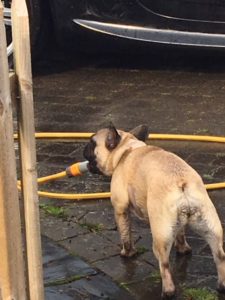Brave Pet of the Month….Roxy
 Roxy is an 18 month little French Bulldog who just loves life and people. We have seen Roxy since a puppy and at an early age noted a heart murmur.
Roxy is an 18 month little French Bulldog who just loves life and people. We have seen Roxy since a puppy and at an early age noted a heart murmur.
Heart murmurs in dogs can be due to a number of reasons. We can try and characterize the type of murmur by the way it sounds and when it occurs. This, coupled with the age, breed and current health of the dog can then help narrow down the list of likely causes. Ultimately however, we cannot be certain about the exact cause without visualising the heart itself. An ultrasound scan of the heart is the best way to do this as it shows the real time movement and structure of the heart. This includes how the heart contracts and relaxes, the movement and integrity of the heart valves and the direction and pressure of blood moving through it. For some patients, further tests such as x-rays and blood tests can help to get a complete clinical picture.
 In between Roxy’s annual booster appointments her heart murmur had become louder in nature. Although Roxy was as lively and happy as ever, it was due to this progression that we decided to investigate further.
In between Roxy’s annual booster appointments her heart murmur had become louder in nature. Although Roxy was as lively and happy as ever, it was due to this progression that we decided to investigate further.
Determining the exact reason for a heart murmur before the issue starts to affect the patient can be very beneficial; in some instances there are procedures available to help improve the condition and in others early introduction of medications has been shown to improve survival time. Knowing the exact cause and stage of the problem can then help to guide how often we repeat imaging and if medications haven’t already been started it helps to pinpoint the optimal time.
We booked Roxy for a heart scan with our visiting cardiologist, Hannah Stephenson. Roxy’s scan showed a condition called pulmonic stenosis. This means narrowing of the pulmonary artery. The pulmonary artery is the big vessel leaving the right hand side of the heart; it takes de-oxygenated blood to the lungs where it is oxygenated and returned back to the heart. Pulmonic stenosis is often a congenital condition meaning it is likely Roxy was born with it. The condition can get worse up to the age of 2 years at which point it tends to stabilise; this explains why Roxy’s murmur had become louder.
The stenosis usually arises due to abnormal development of the pulmonic valve or in some cases due to physical narrowing of the pulmonary artery itself. There are varying degrees of severity and in very mild cases the disease may never affect the individual. However, dogs with severe pulmonic stenosis are likely to develop signs of their disease at some point in their lives. The most common sign is fainting after excitement or exercise but sudden death and ultimately heart failure can occur.
 Roxy’s pulmonic stenosis was characterised as ‘borderline severe’. In such cases, a procedure called balloon valvuloplasty is recommended. This involves the placement of a special catheter into the heart. The catheter has the ability to be inflated to create a rounded balloon type swelling. This region of the catheter is positioned in the abnormal valve so that when inflated it acts to burst open the abnormal valve and reverse some of the stenosis. Despite a non-invasive technique it is not without it’s risks and her owner’s had a big decision to make. They elected to go for the surgery.
Roxy’s pulmonic stenosis was characterised as ‘borderline severe’. In such cases, a procedure called balloon valvuloplasty is recommended. This involves the placement of a special catheter into the heart. The catheter has the ability to be inflated to create a rounded balloon type swelling. This region of the catheter is positioned in the abnormal valve so that when inflated it acts to burst open the abnormal valve and reverse some of the stenosis. Despite a non-invasive technique it is not without it’s risks and her owner’s had a big decision to make. They elected to go for the surgery.
Roxy had her BVP surgery at Liverpool Small Animal Teaching Hospital (SATH). The surgery was deemed a success and within approximately one week I saw Roxy bouncing back into the surgery as loving and happy as ever. She had a small wound on her neck where the catheter was inserted and only three small stitches to remove. So far so good, but Roxy would be due a repeat heart scan in a few weeks to assess her progress. In some cases re-stenosis can occur and it is important to monitor for this possibility.
 Despite some small changes on her heart scan Roxy’s condition is now characterised as ‘mild pulmonic stenosis’ which is brilliant news! This means her risk associated with this condition has markedly decreased. She will still require some tablets to help provide her with the best long term outcome but Roxy takes these absolutely fine.
Despite some small changes on her heart scan Roxy’s condition is now characterised as ‘mild pulmonic stenosis’ which is brilliant news! This means her risk associated with this condition has markedly decreased. She will still require some tablets to help provide her with the best long term outcome but Roxy takes these absolutely fine.
Her owners report Roxy has even more energy post-operatively and is still doing 3 mile walks every day! We are sure you agree that the lovely Roxy deserves our brave pet post!
